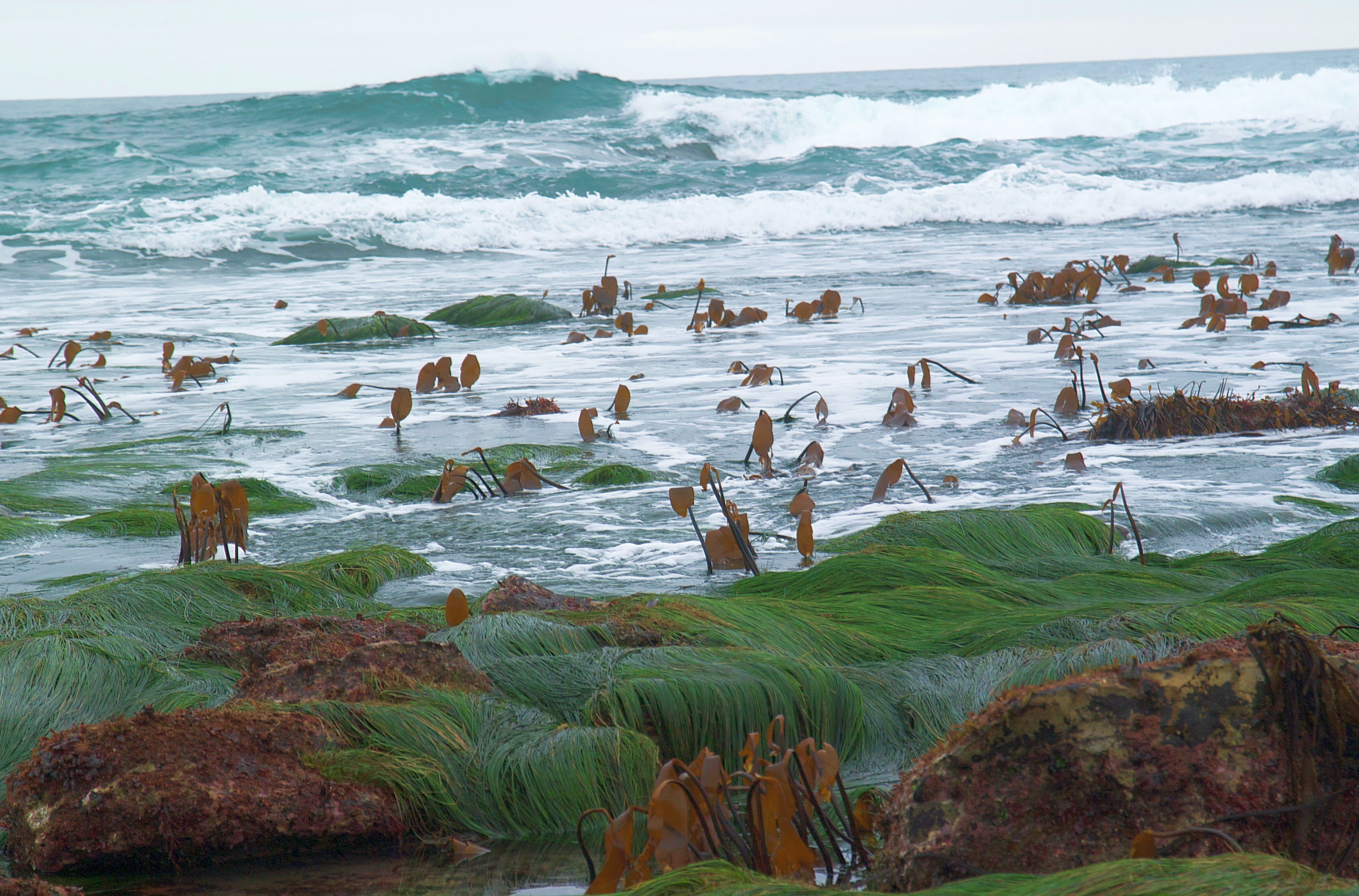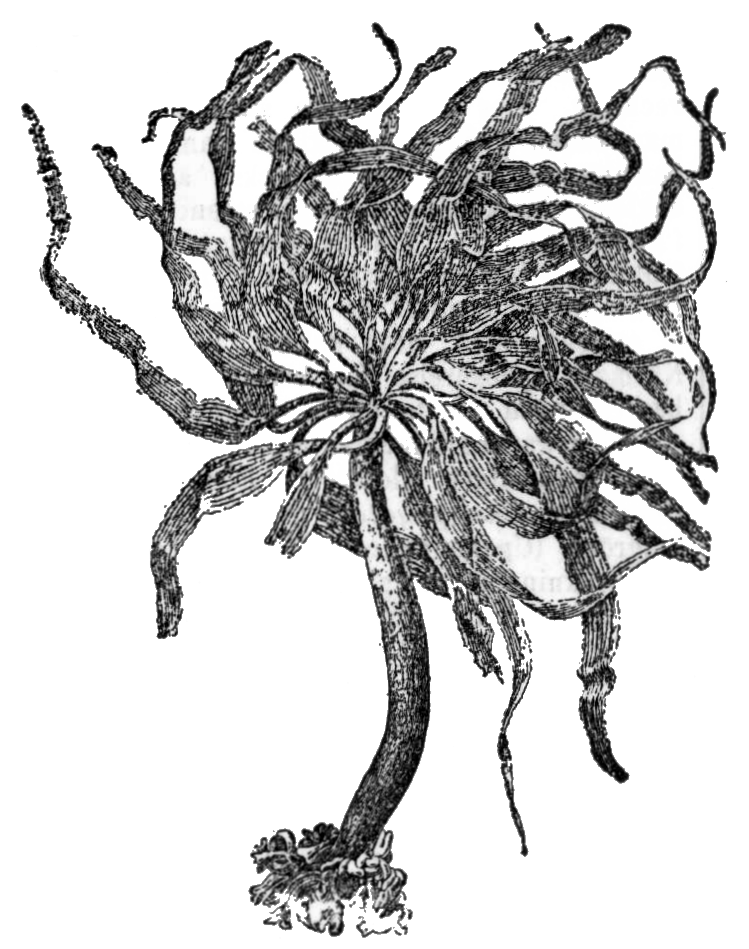|
Laminariaceae
Laminariaceae is a family of brown algal seaweed Seaweed, or macroalgae, refers to thousands of species of macroscopic, multicellular, marine algae. The term includes some types of ''Rhodophyta'' (red), ''Phaeophyta'' (brown) and ''Chlorophyta'' (green) macroalgae. Seaweed species such as ke ...s, many genera of which are popularly called "kelp". The table indicates the genera within this family. Guiry, M.D. & Guiry, G.M. (2006). AlgaeBase version 4.2. World-wide electronic publication, National University of Ireland, Galway. http://www.algaebase.org''Laminariaceae''genera retrieved December 19, 2009. The family includes the largest known seaweeds: ''Nereocystis'' and ''Macrocystis''.van den Hoek, C., Mann, D.G. and Jahns, H.M. 1995. Algae An Introduction to Phycology'. University of Cambridge. References |
Laminaria Hyperborea
''Laminaria hyperborea'' is a species of large brown alga, a kelp in the family Laminariaceae, also known by the common names of tangle and cuvie. It is found in the sublittoral zone of the northern Atlantic Ocean. A variety, ''Laminaria hyperborea f. cucullata'' (P.Svensden & J.M.Kain, 1971) is known from more wave sheltered areas in Scandinavia. Description ''Laminaria hyperborea'' is a massive, leathery seaweed, up to 360 cm long.Newton, L. 1931. ''A Handbook of the British Seaweeds.'' British Museum, London The holdfast is large and cone-shaped, with branched rhizoids, looking rather like a bird's foot. The stipe is circular in cross section, rough, thick at the base and tapering upwards. Older stipes are often covered with epiphytic red algae. The laminate blade is deeply divided into linear segments and is yellowish brown with large digitate segments. [...More Info...] [...Related Items...] OR: [Wikipedia] [Google] [Baidu] |
Brown Alga
Brown algae (singular: alga), comprising the class Phaeophyceae, are a large group of multicellular algae, including many seaweeds located in colder waters within the Northern Hemisphere. Brown algae are the major seaweeds of the temperate and polar regions. They are dominant on rocky shores throughout cooler areas of the world. Most brown algae live in marine environments, where they play an important role both as food and as a potential habitat. For instance, ''Macrocystis'', a kelp of the order Laminariales, may reach in length and forms prominent underwater kelp forests. Kelp forests like these contain a high level of biodiversity. Another example is ''Sargassum'', which creates unique floating mats of seaweed in the tropical waters of the Sargasso Sea that serve as the habitats for many species. Many brown algae, such as members of the order Fucales, commonly grow along rocky seashores. Some members of the class, such as kelps, are used by humans as food. Between 1,500 ... [...More Info...] [...Related Items...] OR: [Wikipedia] [Google] [Baidu] |
Arthrothamnus
''Arthrothamnus'' is a genus of brown alga comprising approximately 2 species. It includes the algae commonly known as nekoashi-kombu, oarweed and chishima-nekoashi-kombu. ''Bifurcariopsis'' reproduces by means of conceptacles; it produces tetraspores and dispores and carpospores. Species The two species currently recognised are '' Arthrothamnus bifidus'' and ''Arthrothamnus kurilensis ''Arthrothamnus'' is a genus of brown alga comprising approximately 2 species. It includes the algae commonly known as nekoashi-kombu, oarweed and chishima-nekoashi-kombu. ''Bifurcariopsis'' reproduces by means of conceptacles; it produces tetr ...''. References * Laminariaceae Laminariales genera {{phaeophyceae-stub ... [...More Info...] [...Related Items...] OR: [Wikipedia] [Google] [Baidu] |
Laminaria
''Laminaria'' is a genus of brown seaweed in the order Laminariales (kelp), comprising 31 species native to the north Atlantic and northern Pacific Oceans. This economically important genus is characterized by long, leathery laminae and relatively large size. Some species are called Devil's apron, due to their shape, or sea colander, due to the perforations present on the lamina. Others are referred to as ''tangle''. ''Laminaria'' form a habitat for many fish and invertebrates. The life cycle of ''Laminaria'' has heteromorphic alternation of generations which differs from '' Fucus''. At meiosis the male and female zoospores are produced separately, then germinate into male and female gametophytes. The female egg matures in the oogonium until the male sperm fertilizes it. Life-Cycle: The most apparent form of ''Laminaria'' is its sporophyte phase, a structure composed of the holdfast, the stipe, and the blades. While it spends its time predominately in the sporophyte pha ... [...More Info...] [...Related Items...] OR: [Wikipedia] [Google] [Baidu] |
Macrocystis
''Macrocystis'' is a monospecific genus of kelp (large brown algae). This genus contains the largest of all the phaeophyceae or brown algae. ''Macrocystis'' has pneumatocysts at the base of its blades. Sporophytes are perennial and the individual may live for up to three years; stipes/fronds within a whole individual undergo senescence, where each frond may persist for approximately 100 days. The genus is found widely in subtropical, temperate, and sub-Antarctic oceans of the Southern Hemisphere (e.g. Chile, New Zealand, Australia, Falkland Islands, Auckland Islands, etc.) and in the northeast Pacific from Baja California peninsula, Baja California to Sitka, Alaska. ''Macrocystis'' is often a major component of temperate kelp forests. Description ''Macrocystis'' is a monospecific genus, the sole species is ''M. pyrifera''. Some individuals are so huge that the thallus may grow to up to 60 m (200 ft).C. van den Hoek, D.G. Mann and H.M. Jahns (1995) Algae An Introduct ... [...More Info...] [...Related Items...] OR: [Wikipedia] [Google] [Baidu] |
Nereocystis
''Nereocystis'' (Greek, 'mermaid's bladder') is a monotypic genus of subtidal kelp containing the species ''Nereocystis luetkeana''. Some English names include edible kelp, bull kelp, bullwhip kelp, ribbon kelp, bladder wrack, and variations of these names. Due to the English name, bull kelp can be confused with southern bull kelps, which are found in the Southern Hemisphere. ''Nereocystis luetkeana'' forms thick beds on subtidal rocks, and is an important part of kelp forests. Etymology The species ''Nereocystis luetkeana'' was named (as ''Fucus luetkeanus'') after the German-Russian explorer Fyodor Petrovich Litke (also spelled Lütke) by Mertens. The species was renamed in a description by Postels and Ruprecht. Description Individuals can grow to a maximum of . ''Nereocystis'' has a holdfast of about , and a single stipe, topped with a pneumatocyst containing carbon monoxide, from which sprout the numerous (about 30-64) blades. The blades may be up to long, and up ... [...More Info...] [...Related Items...] OR: [Wikipedia] [Google] [Baidu] |
Pelagophycus
''Pelagophycus'' is a monotypic genus of kelp. It is found in deep waters off the west coast of central North America. The species ''Pelagophycus porra'', also known as Elk kelp, grows in temperatures of no higher than . It grows in subtidal forests in the coastal waters off southern California and northwestern Baja California Peninsula, in waters of to deep, anchored by a holdfast in sedimentary or loose sediment bottoms.Guiry, M.D. & Guiry, G.M. 2013''Pelagophycus'' Areschoug, 1881 AlgaeBase, National University of Ireland, Galway. http://www.algaebase.org; searched on 7 February 2013. Three ecotypes are recognized: :''Pelagophycus giganteus'' :''Pelagophycus porra'' :''Pelagophycus intermedius'' References Further reading * {{Taxonbar, from=Q15159638, from2=Q7161168 Laminariaceae Flora of the Pacific Marine biota of North America Flora of California Flora of Baja California Flora of Baja California Sur Flora of the West Coast of the United States N ... [...More Info...] [...Related Items...] OR: [Wikipedia] [Google] [Baidu] |
Postelsia
''Postelsia palmaeformis'', also known as the sea palm (not to be confused with the southern sea palm) or palm seaweed, is a species of kelp and classified within brown algae. It is the only known species in the genus Postelsia. The sea palm is found along the western coast of North America, on rocky shores with constant waves. It is one of the few algae that can survive and remain erect out of the water; in fact, it spends most of its life cycle exposed to the air. It is an annual, and edible, though harvesting of the alga is discouraged due to the species' sensitivity to overharvesting. History The sea palm was known by the natives of California by the name of kakgunu-chale before any Europeans entered the region. ''Postelsia'' was first scientifically described by Franz Josef Ruprecht (1814–1870) in 1852 from a specimen found near Bodega Bay in California. Ruprecht, an Austro-Hungarian who became curator of botany at the Academy of Sciences in St. Petersburg in 1839, s ... [...More Info...] [...Related Items...] OR: [Wikipedia] [Google] [Baidu] |
Saccharina
''Saccharina'' is a genus of 24 species of Phaeophyceae (brown algae). It is found in the north Atlantic Ocean and the northern Pacific Ocean at depths from 8 m to 30 m (exceptionally to 120 m in the warmer waters of the Mediterranean Sea and off Brazil). The commercially important species ''Saccharina japonica'' (''Laminaria japonica'') is cultivated as kombu, a popular food in Japan. Species The following is a list of the 24 species of ''Saccharina'': * ''Saccharina angustata'' (Kjellman) C.E. Lane, C. Mayes, Druehl & G.W. Saunders *''Saccharina angustissima'' (Collins) Augyte, Yarish & Neefus * ''Saccharina bongardiana'' (Postels & Ruprecht) Selivanova, Zhigadlova & G.I. Hansen * '' Saccharina cichorioides'' (Miyabe) C.E. Lane, C. Mayes, Druehl & G.W. Saunders * ''Saccharina coriacea'' (Miyabe) C.E. Lane, C. Mayes, Druehl & G.W. Saunders *''Saccharina complanata'' (Setchell & N.L.Gardner) Gabrielson, Lindstrom & O'Kelly * '' Saccharina crassifolia'' (Pos ... [...More Info...] [...Related Items...] OR: [Wikipedia] [Google] [Baidu] |
Family (biology)
Family ( la, familia, plural ') is one of the eight major hierarchical taxonomic ranks in Linnaean taxonomy. It is classified between order and genus. A family may be divided into subfamilies, which are intermediate ranks between the ranks of family and genus. The official family names are Latin in origin; however, popular names are often used: for example, walnut trees and hickory trees belong to the family Juglandaceae, but that family is commonly referred to as the "walnut family". What belongs to a family—or if a described family should be recognized at all—are proposed and determined by practicing taxonomists. There are no hard rules for describing or recognizing a family, but in plants, they can be characterized on the basis of both vegetative and reproductive features of plant species. Taxonomists often take different positions about descriptions, and there may be no broad consensus across the scientific community for some time. The publishing of new data and opi ... [...More Info...] [...Related Items...] OR: [Wikipedia] [Google] [Baidu] |
Seaweed
Seaweed, or macroalgae, refers to thousands of species of macroscopic, multicellular, marine algae. The term includes some types of ''Rhodophyta'' (red), ''Phaeophyta'' (brown) and ''Chlorophyta'' (green) macroalgae. Seaweed species such as kelps provide essential nursery habitat for fisheries and other marine species and thus protect food sources; other species, such as planktonic algae, play a vital role in capturing carbon, producing at least 50% of Earth's oxygen. Natural seaweed ecosystems are sometimes under threat from human activity. For example, mechanical dredging of kelp destroys the resource and dependent fisheries. Other forces also threaten some seaweed ecosystems; a wasting disease in predators of purple urchins has led to a urchin population surge which destroyed large kelp forest regions off the coast of California. Humans have a long history of cultivating seaweeds for their uses. In recent years, seaweed farming has become a global agricultural practice, p ... [...More Info...] [...Related Items...] OR: [Wikipedia] [Google] [Baidu] |
.jpg)




